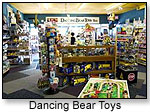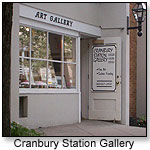 |

Tools:








Retailing Tips: When One Store Isn't Enough11 Pointers on How to Expand Your Specialty Business
| With larger orders, "you tend to get free freight or longer paying terms.” — Erika Evers, Dancing Bear Toys |
How do you know when it’s time to open another location? And what do you do when it is time?
Nick Morolda of Independent Profit & Management and his wife, Kathleen, who own Cranbury Station Gallery in Monroe Township and Princeton, N.J., advised retailers about multiple store locations at this year’s Toy Fair. Toy-store owners Erika Evers of Dancing Bear Toys in Hendersonville, N.C., and Michael Zeigenhagen, of four Playmatters stores in metropolitan Cleveland, shared their experiences with TDmonthly Magazine, too:
 Establish a Track Record. Before opening a second store, make sure your first is "comfortably in the black," with a history that allows for reliable sales predictions, Zeigenhagen said. "A store needs about three years to establish a track record, to ensure that the decision was a sound one and there's a synergy between the store and the community it serves." Establish a Track Record. Before opening a second store, make sure your first is "comfortably in the black," with a history that allows for reliable sales predictions, Zeigenhagen said. "A store needs about three years to establish a track record, to ensure that the decision was a sound one and there's a synergy between the store and the community it serves."
- Seize Opportunities. In 1997, several years after the opening of the first Dancing Bear Toys, "We actually were approached by the owner of a Hendersonville [N.C.] toy store," Evers said. "He was retiring and contacted us to see if we wanted to take his lease."
- Know the Community. Research the area in which you're thinking of opening a store. Ask area businesses, 'What's your customer like? What's their average income?'" Kathleen advised. In an attempt to open a third store, the Moroldas selected a community with large houses that seemed promising in terms of spending power, but wasn't. They hadn't talked with storeowners, joined the Chamber of Commerce or gotten to know the community. Zeigenhagen has had to question whether traffic volume in an area could offset lower income levels that don't match his stores' demographic.
- Choose Locations Wisely. Make sure the store locations are far enough apart not to cannibalize each others' sales, Nick warned. "Location is really important," agreed Evers.
 Maintain Cash Flow. If you decide to utilize another location, provide a large enough cash reserve for the first store to subsidize the second while business is growing, Nick said. Maintain Cash Flow. If you decide to utilize another location, provide a large enough cash reserve for the first store to subsidize the second while business is growing, Nick said.
- Exploit Your Buying Power. Evers told TDmonthly that increased buying power with two locations has helped their stores' success. With larger orders, she said, "you tend to get free freight or longer paying terms, and we're able to keep more stock because of it."
- Differentiate Each Store. Ziegenhagen told TDmonthly that expansion is about "finding the right location, the right demographic, and matching it to the right product assortment and service factor." He had to "fine-tune the staff and the assortment to match the marketplaces" for each new location.
- Capitalize on Specialty. Consider product you can offer that's not available in the mass market, Nick said. Zeigenhagen noted that "a lot of people don't know what specialty retail is anymore," but they start to understand it when they have a unique shopping experience and different level of service and interaction with staff.
 Staff for Success. The decision to open a second store depends on having the right people to help you do it, Evers said. Her family has high expectations of staff, she added, but retaining good employees can be challenging. Staff for Success. The decision to open a second store depends on having the right people to help you do it, Evers said. Her family has high expectations of staff, she added, but retaining good employees can be challenging.
- Know When to Slow Down. After a year and a half of managing three Dancing Bear Toys locations, all within 30 minutes of each other, the Evers Family — Erika, her sister and her parents — decided it was too much. They closed the third store, Evers said, because "we were spread too thin."
- Know When to Keep Going. Ziegenhagen believes that if he had acted more quickly, Playmatters could’ve surpassed its four-store count years ago. “We could have been a multi-metropolitan area operation,” he said. “Probably a little bit of venture capital could have achieved that level during the 1990s.”
 Writer's Bio: Writer's Bio: Julie L. Jones has written articles for both newspapers and magazines. Before joining the staff of TDmonthly Magazine, she worked as a communications writer and provided editorial support for a market research company. Read more articles by this author
THIS BANNER IS AN AD:

• • • • • • • • • • • • • • • • • • • • • | • • • • • • • • • • • • • • • • • • • • |
Back to TDmonthly's front page
|  |
Advertise on TDmonthly

|

